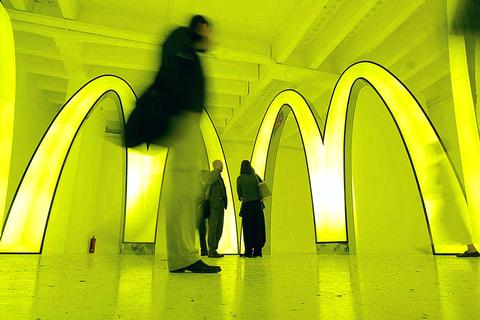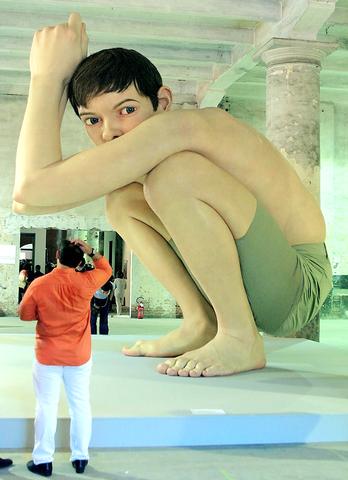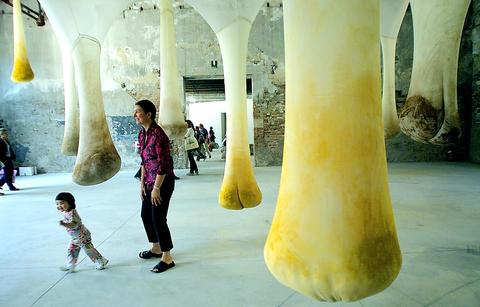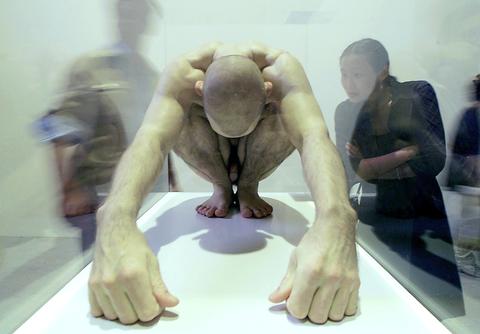As the city steadily sinks into the surrounding canals, and gondolas wistfully float by in the dazzling Mediterranean sun, a highly prestigious international arts exhibition, the Venice Biennale, opened yesterday and will run through Nov. 4. Taiwan has added a national pavilion to the show, but the main interest for many art lovers is in the Aperto, an "open" show that does not have any nationalist axe to grind.
On with the show

PHOTO: AFP
The Venice Biennale was founded in 1895, approximately the same time as the Olympic Games (1896). This was not a coincidence, as the establishment of both events was based on the belief that arts and sports transcended national borders and could serve as an alternative to imperialistic competition between Western nations.

PHOTO: AFP
Considered to be the "madre" of the art biennale, the Venice Biennale has inspired over 50 worldwide biennales including Kwangju, Taipei, Istanbul, Berlin, Dakar and Johannesburg. The event was designated an event of national importance in 1998 by the Italian Parliament for its role in promoting culture.
This year's Venice Biennale continues to be driven by the desire to break down barriers between regions and people by giving voice to previously ignored or marginalized groups.

PHOTO: REUTERS
The exhibition is divided into two sections: national pavilions and the Aperto.

PHOTO: REUTERS
Approximately 40 countries (mostly developed Western nations) have their own permanent pavilions scattered through the Giardini Pubblici (public gardens). The art chosen for the national pavilions is mainly chosen by government committees, and the criteria for choosing the art in most cases has little to do with aesthetic issues.
The Aperto features younger artists, and through the juxtaposition of these exhibitions, the Venice Biennale seeks dialogue and debate about what is national art and what is international art. The Aperto features works selected by Harald Szeemann, this year's director of the Venice Biennale, and includes artists from the often overlooked areas of Africa, Latin America and Scandinavia. Much of the Aperto exhibition takes place in the Arsenale, but there are many works displayed in unexpected places as well.
Linked humanity
Plateau of Humankind is the theme for this year's Aperto. It is Szeemann's belief that human cultures are like high plateaus separated by deep valleys. For him, the Aperto functions as a shared elevated space that offers a total view of humanity. This idea is expressed in an exhibit called the Plateau of Thought, in which a group of sculptures, with Rodin's The Thinker as the focal point, are displayed amid a collection of Buddhist and African, Indian tantric ritual objects on a platform.
According to Szeemann, artists now tend to appeal to what is eternal in humanity rather than focusing on their individual identities. Because of this, certain shared themes are apparent in this show, themes such as colonization, urbanism, human suffering, the beauty of life and the low social status of the artist.
Thematic variety
In addition to the visual arts, the Venice Biennale includes cinema, poetry, dance, music, and theater to create a "total art." Well-known filmmakers Atom Egoyan and Chantal Akerman are showing their work in the context of the art exhibition because they believe that much of today's contemporary art is cinematic. While there are many good film and video works on show, the sheer volume of footage means that there is also an overabundance of mediocre video and film work, creating the impression that audio-visual art is a lazy man's form of art.
Poems have been attached to a fence that separates the art area from the military areas of the Arsenale and is labeled "poetry as a defense of humanity." The music and theater sections are scheduled for August and September respectively. Even with the inclusion of these various disciplines, it is really in the field of visual arts where the greatest innovations and biggest risks are being taken at the Venice Biennale, and it is for contemporary art that the show is generally known.
Upon entering the Corderie where the Aperto exhibition begins, visitors are confronted by a 4.9m-high sculpture of a young boy whose red-rimmed eyes peek out from under his elongated arm. This work reflects artist Ron Mueck's fear and horror of the world he faces and his suspicion of authority, setting the tone for this exhibition of young artists.
The sense of the world being in flux is expressed in Nedko Solakov's work A Life (Black and White), in which two workers constantly repaint a room's walls for the duration of the exhibition. One worker starts from the left corner of the room and paints the walls black with a roller. Across the room, the second worker paints the black walls white.
The theme of colonialism is most strongly expressed in filmmakers Yervant Gianikian's and Angela Ricci Lucchi's video images taken from Western anthropological films made about the "African savage."
A sarcastic reference to the preening of artists themselves is made by Francis Alys, whose work was to released two peacocks into the Giardini as a metaphor for artists who "strut their stuff" at art openings. But it is hard to get a glimpse of this work, for the birds are rather elusive.
Art and commerce where
powerfully juxtaposed by artist Tsai Kuo-Chiang's project Refreshing. The work is a person on Chinese-style bicycle cart peddling around near the canals selling bottles of water.
Since many of the national pavilions shy away from showing challenging work, it is unusual to find any really outstanding work here. But this year the German pavilion has put on a bold display by artist Gregor Schneider, who has built a house within a house complete with double walls and claustrophobic hidden passages. Passing through the labyrinth of the house with its inner walls and tunnels is psychologically harrowing, and is strongly evocative of hideouts during the Nazi persecution of Jews and other minorities.
Besides the national pavilions and Aperto, many other alternative exhibitions are also taking place. Authentic/Eccentric, a group show of contemporary African artists, is one of the best exhibitions to see due to the high quality and provocative nature of the works.
During the opening week, for a project called In The Sky, a team of professional skywriters rewrote words or re-drew images provided by a group of artists, showing that contemporary art is basically symbolic production and is not confined to the traditional trappings of canvas, paper or the space of a gallery.
For your information:
For more detailed coverage of the Venice Biennale, see the official Web site: http://www.labiennale.org. Live interviews and the opening ceremony will be broadcast on
http://www.biennale24.com.
Next week in Arts Journal, the `Taipei Times' will take a closer look at the works shown at the Taiwan, Hong Kong and Singapore pavilions.

April 28 to May 4 During the Japanese colonial era, a city’s “first” high school typically served Japanese students, while Taiwanese attended the “second” high school. Only in Taichung was this reversed. That’s because when Taichung First High School opened its doors on May 1, 1915 to serve Taiwanese students who were previously barred from secondary education, it was the only high school in town. Former principal Hideo Azukisawa threatened to quit when the government in 1922 attempted to transfer the “first” designation to a new local high school for Japanese students, leading to this unusual situation. Prior to the Taichung First

When the South Vietnamese capital of Saigon fell to the North Vietnamese forces 50 years ago this week, it prompted a mass exodus of some 2 million people — hundreds of thousands fleeing perilously on small boats across open water to escape the communist regime. Many ultimately settled in Southern California’s Orange County in an area now known as “Little Saigon,” not far from Marine Corps Base Camp Pendleton, where the first refugees were airlifted upon reaching the US. The diaspora now also has significant populations in Virginia, Texas and Washington state, as well as in countries including France and Australia.

On April 17, Chinese Nationalist Party (KMT) Chairman Eric Chu (朱立倫) launched a bold campaign to revive and revitalize the KMT base by calling for an impromptu rally at the Taipei prosecutor’s offices to protest recent arrests of KMT recall campaigners over allegations of forgery and fraud involving signatures of dead voters. The protest had no time to apply for permits and was illegal, but that played into the sense of opposition grievance at alleged weaponization of the judiciary by the Democratic Progressive Party (DPP) to “annihilate” the opposition parties. Blamed for faltering recall campaigns and faced with a KMT chair

Article 2 of the Additional Articles of the Constitution of the Republic of China (中華民國憲法增修條文) stipulates that upon a vote of no confidence in the premier, the president can dissolve the legislature within 10 days. If the legislature is dissolved, a new legislative election must be held within 60 days, and the legislators’ terms will then be reckoned from that election. Two weeks ago Taipei Mayor Chiang Wan-an (蔣萬安) of the Chinese Nationalist Party (KMT) proposed that the legislature hold a vote of no confidence in the premier and dare the president to dissolve the legislature. The legislature is currently controlled